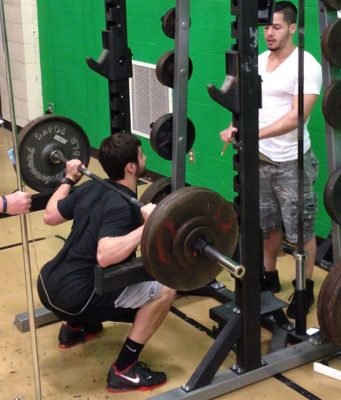Scientists have studied how muscles respond to exercise for decades, but research at the University of Kansas is among the first to look specifically at what happens inside the cell and the role hormones and cellular receptors play in response to weight training. The findings could lead to more individualized exercise routines based on a person’s body type, training experience and other factors, and they could help people recover from injuries faster as well.
Justin Nicoll, doctoral student at KU, and Andrew Fry, professor of health, sport & exercise science, have conducted several studies examining how hormones such as testosterone affect muscular responses to exercise. Recently, it has been suggested that hormones play little role, if any, in muscular adaptation. But Nicoll’s work is showing that was an oversimplification and they indeed have a part, and illustrating how they interact with receptors inside the cell.

Justin Nicoll, KU doctoral student, standing, observes a study participant in the Jayhawk Athletic Performance Laboratory. Nicoll and Andrew Fry, professor of health, sport and exercise science, have published research shedding new light on the roles of hormones in muscle response to resistance training. Photo credit: Andrew Fry
“Justin has spent a lot of time looking at what goes on inside the cell,” Fry said. “There’s a place inside where the hormone docks are called receptors, and he’s finding out it’s not just how many docks there are, or how much of the hormone there is, but that these receptors can be regulated, or turned on and off depending on the exercise stimulus.”
In their studies, Fry and Nicoll take muscle biopsies from both men and women, some trained athletes and others not, at various points after performing weight-training exercises. The samples are frozen, then specific proteins are isolated and have antibodies attached that allow them to measure the total and activated amounts, as well as where and how they responded to hormones such as testosterone, cortisol and others. The knowledge that steroid receptors can be phosphorylated, or turned on and off, in muscle is relatively new in humans. It has been studied in cell culture and animals, but the KU studies are among the first to look at the process in human muscle.
“It’s kind of like a dimmer on a light switch. The cell is telling things to turn on and off at various points,” Nicoll said of phosphorylation. “How is that expressed in human muscle and how is it affected by exercise?”
The research thus far has taken samples at rest immediately after or 10 minutes after exercise in trained athletes. The results will be compared to samples taken in a series during and at longer periods after rest, from both trained and nontrained individuals, both male and female. The results will shed light on the optimum time to rest between exercises, how often to perform certain exercises to increase strength in specific muscle groups, and how the exercises may vary in effectiveness by gender, body type and individual genetics. They are also looking at individuals who use certain nutritional supplements while weight training to find out what role they play in the cellular hormonal response to resistance exercise.
“This shows there might be ways to optimize training regimens,” Nicoll said. “We’re learning some adaptations and responses to exercise are genetic, but still, maybe we can help people train in a way to optimize the response for you.”
The results have also shown that certain hormonal responses inside the cell reduce with increased training. As they learn more about when and why receptors stop functioning, the findings could be applied to help prevent overtraining, find out what rest and recovery times are optimal and how to keep hormone receptors from becoming worn out.
Nicoll and Fry will be presenting their findings this summer at the National Strength and Conditioning Association’s Annual Conference in Indianapolis and publishing the results from their studies. As they learn more about hormone receptors and the cellular responses to exercise, Fry said the research is already validating that hormones and their phosphorylated receptors have a lot to teach us about physiology and biochemistry.
“Some of this data is starting to crack the door open and show that there’s more to study there. The human body is such a complex organism, and there’s still so much more to learn. It’s not an easy area to study, but we’re seeing there’s a lot more to hormones than growth.”
Source: University of Kansas
This content was originally published here.









